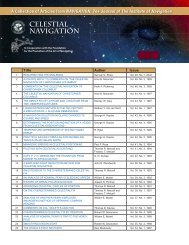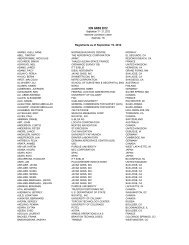The N5G Inertial Navigation System in the B-52 Hound DogMissile A ...
The N5G Inertial Navigation System in the B-52 Hound DogMissile A ...
The N5G Inertial Navigation System in the B-52 Hound DogMissile A ...
Create successful ePaper yourself
Turn your PDF publications into a flip-book with our unique Google optimized e-Paper software.
Dur<strong>in</strong>g <strong>the</strong> <strong>in</strong>itial portion of free flight, missile speed, altitude, and stability <strong>in</strong> <strong>the</strong><br />
three axes are controlled by <strong>the</strong> flight control system. When <strong>the</strong> cruise mode is<br />
reached, control <strong>in</strong> <strong>the</strong> lateral plane is accomplished by means of bank angle<br />
commands generated by <strong>the</strong> guidance system. High or low longitud<strong>in</strong>al cruise<br />
control can be selected for <strong>the</strong> missile prior to launch.<br />
Low-level Cruise - When <strong>the</strong> signals applied as pitch command, <strong>the</strong> missile levels<br />
off and ma<strong>in</strong>ta<strong>in</strong>s <strong>the</strong> pre-selected altitude until <strong>the</strong> guidance system detonates <strong>the</strong><br />
warhead over <strong>the</strong> target. <strong>The</strong>re is no dive or verical mode <strong>in</strong> low-level flight.<br />
High-level Cruise - In this mode, <strong>the</strong> missile is commanded to seek <strong>the</strong> referenced<br />
pitot pressure, and descends or ascends (depend<strong>in</strong>g on launch conditions). This<br />
mode cont<strong>in</strong>ues until term<strong>in</strong>ated by a Dive command signal from <strong>the</strong> INS.<br />
Dive - Started by <strong>the</strong> dive-<strong>in</strong>itate signal from <strong>the</strong> INS approximately 30 seconds<br />
from target; <strong>the</strong> eng<strong>in</strong>e is shut down and <strong>the</strong> vertical gyro torqued at a constant rate<br />
to allow <strong>the</strong> airframe to nose over to <strong>the</strong> straight-<strong>in</strong> dive attitude.<br />
SUMMARY – <strong>The</strong> GAM-77 <strong>Hound</strong> Dog missile carried by and launched from <strong>the</strong><br />
B-<strong>52</strong> strategic bomber, is considered to be one of <strong>the</strong> earliest, and most successful,<br />
applications of <strong>Inertial</strong> <strong>Navigation</strong> technology. It was a monumental achievement,<br />
not only <strong>in</strong> how rapidly it was designed, developed and operationally deployed, but<br />
for <strong>the</strong> message of technical competence and superiority it broadcast to <strong>the</strong> world.<br />
<strong>The</strong> B-<strong>52</strong> strategic bomber, armed with <strong>the</strong> GAM-77 <strong>Hound</strong> Dog, was a ma<strong>in</strong>stay<br />
of America’s nuclear arsenal from 1959 until 1976, when <strong>the</strong> Gam-77 was phased<br />
out and replaced by <strong>the</strong> SRAM Missile, and later <strong>the</strong> Air-Launched Cruise Missile.<br />
References:<br />
1. Strategic Air Command Tran<strong>in</strong>g Manual, SACM 50-11 “AGM-28 A/B<br />
Operational Manual” 30 August 1965, issued by HQ-SAC<br />
2. Strategic Air Command Tran<strong>in</strong>g Manual, SACM 55-10 “Combat Tra<strong>in</strong><strong>in</strong>g<br />
and <strong>Navigation</strong> Tactical Procedures” 23 July 1962, issued by HQ-SAC<br />
3. Tech. Order 21-GAM77-2-1 Ma<strong>in</strong>tenance and Operation Data<br />
10







